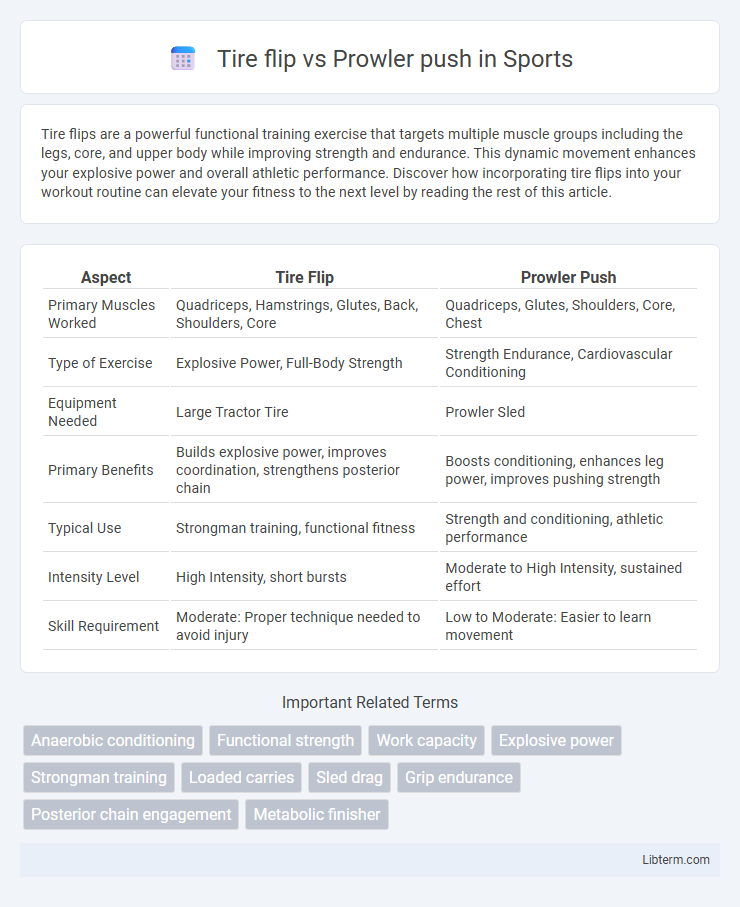Tire flips are a powerful functional training exercise that targets multiple muscle groups including the legs, core, and upper body while improving strength and endurance. This dynamic movement enhances your explosive power and overall athletic performance. Discover how incorporating tire flips into your workout routine can elevate your fitness to the next level by reading the rest of this article.
Table of Comparison
| Aspect | Tire Flip | Prowler Push |
|---|---|---|
| Primary Muscles Worked | Quadriceps, Hamstrings, Glutes, Back, Shoulders, Core | Quadriceps, Glutes, Shoulders, Core, Chest |
| Type of Exercise | Explosive Power, Full-Body Strength | Strength Endurance, Cardiovascular Conditioning |
| Equipment Needed | Large Tractor Tire | Prowler Sled |
| Primary Benefits | Builds explosive power, improves coordination, strengthens posterior chain | Boosts conditioning, enhances leg power, improves pushing strength |
| Typical Use | Strongman training, functional fitness | Strength and conditioning, athletic performance |
| Intensity Level | High Intensity, short bursts | Moderate to High Intensity, sustained effort |
| Skill Requirement | Moderate: Proper technique needed to avoid injury | Low to Moderate: Easier to learn movement |
Introduction: Tire Flip vs Prowler Push
Tire flip and prowler push are dynamic strength training exercises targeting full-body power development. Tire flips engage explosive hip extension, grip strength, and coordination, effectively working the posterior chain and upper body muscles. Prowler pushes emphasize lower body drive, core stability, and cardiovascular endurance, making them essential for building functional strength and conditioning.
Overview of Functional Strength Training
Tire flips and prowler pushes are cornerstone exercises in functional strength training, targeting multi-joint movements that enhance overall power, coordination, and endurance. Tire flips engage the posterior chain, including glutes, hamstrings, and lower back, while demanding explosive hip and core strength, crucial for athletic performance and injury prevention. Prowler pushes emphasize lower-body drive, core stability, and cardiovascular fitness by replicating real-world pushing motions, making them highly effective for developing functional strength and conditioning.
Tire Flip: Exercise Description and Technique
The Tire Flip is a dynamic full-body exercise that targets strength, power, and conditioning by requiring athletes to lift and flip a heavy tire using a combination of lower body drive and upper body force. Proper technique involves squatting down with a neutral spine, gripping the tire's underside, generating power through the hips and legs, and explosively driving the tire forward while extending the hips and knees. Emphasizing proper form reduces injury risk and maximizes muscle engagement in the quadriceps, hamstrings, glutes, and core during each repetition.
Prowler Push: Exercise Description and Technique
The Prowler push targets the lower body, core, and cardiovascular system by pushing a weighted sled across a surface, emphasizing leg drive and hip extension for explosive power. Proper technique involves maintaining a low, forward-leaning posture with a neutral spine, gripping the sled handles firmly, and driving through the legs while keeping the core engaged to stabilize the movement. This exercise effectively enhances muscular endurance, strength, and anaerobic conditioning, making it a versatile tool for athletic performance and functional fitness development.
Muscle Groups Targeted: Tire Flip vs Prowler Push
The tire flip primarily targets the quadriceps, hamstrings, glutes, and lower back while also engaging the shoulders and arms for lifting and pushing the tire. The prowler push emphasizes the quadriceps, glutes, and calves with significant activation of the core and upper back muscles to stabilize and drive the sled forward. Both exercises improve total-body strength and power, but tire flips engage more upper body pulling muscles, whereas prowler pushes focus heavily on lower body driving muscles.
Cardiovascular and Conditioning Benefits
Tire flips and prowler pushes both enhance cardiovascular endurance and conditioning by engaging large muscle groups through high-intensity, full-body movements. Tire flipping primarily improves explosive power and anaerobic capacity by requiring rapid bursts of strength, while prowler pushes emphasize sustained muscular endurance and aerobic conditioning through continuous, controlled effort. Incorporating both exercises into training maximizes heart rate elevation and metabolic conditioning for improved overall fitness.
Power and Explosiveness: Comparative Analysis
Tire flips engage the posterior chain, including glutes, hamstrings, and lower back, generating raw power through a full-body explosive movement. Prowler pushes emphasize lower body strength and anaerobic endurance by driving force through the quads and calves with a focus on continuous, controlled power output. Both exercises develop explosiveness, but tire flips demand rapid force production, whereas prowler pushes build sustained power and acceleration capacity.
Injury Risk and Safety Considerations
Tire flips place considerable stress on the lower back and shoulders, increasing the risk of strains and acute injuries if performed with improper form or insufficient warm-up. Prowler pushes distribute load more evenly across the lower body and core, generally posing a lower injury risk while enhancing joint stability and muscular endurance. Prioritizing technique, gradual load progression, and adequate recovery are essential safety considerations for both exercises to minimize injury potential.
Which Exercise Fits Your Fitness Goals?
Tire flips primarily build explosive power and full-body strength by engaging muscles in the legs, back, arms, and core, making them ideal for athletes and powerlifters. Prowler pushes enhance cardiovascular endurance and lower body strength with a focus on sustained effort and conditioning, suited for endurance athletes and general fitness enthusiasts. Choose tire flips for maximum strength gains and power development, while prowler pushes are better for improving stamina and functional conditioning.
Conclusion: Choosing Between Tire Flip and Prowler Push
Selecting between the tire flip and prowler push depends on specific training goals, as the tire flip enhances explosive power and total body strength through dynamic lifting, while the prowler push emphasizes sustained lower body endurance and force production during controlled, resisted movement. Athletes seeking to improve functional strength and anaerobic capacity may benefit more from tire flips, whereas those aiming to build muscular endurance and metabolic conditioning might prioritize prowler pushes. Incorporating both exercises strategically can optimize overall performance by targeting complementary muscular and energy system demands.
Tire flip Infographic

 libterm.com
libterm.com